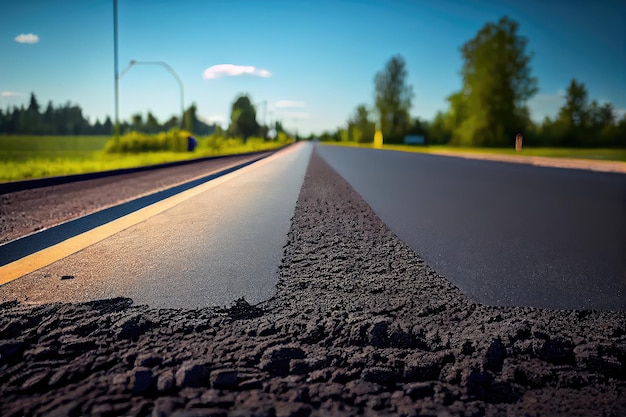Contact Us
RoadVision AI
Private Limited
Office No. 308 & 310, B Block
Ansal Chamber - 1, Bhikaji Cama Place,
Near Engineers India Limited (EIL) Bhawan, New Delhi - 110066
© 2024 | RoadVision AI | All rights reserved
Mix Seal Surfacing (MSS) and Close-Graded Premix Surfacing (CGPS) are essential surface treatments for flexible pavements, offering durability, skid resistance, and cost-effectiveness. The Indian Roads Congress (IRC) introduced IRC:SP:78-2008, which provides detailed specifications for these surfacing methods, ensuring high performance in low-traffic and high-rainfall areas.
In this blog, we will explore the scope, materials, construction techniques, and quality control aspects of this IRC code.

The IRC:SP:78-2008 manual was introduced to standardize Mix Seal Surfacing (MSS) and Close-Graded Premix Surfacing (CGPS), which are used as wearing courses on prepared granular or bituminous bases. This surfacing method is preferred for low-volume roads (up to 10 million standard axles or MSA) and offers better resistance to water infiltration, skid resistance, and surface durability.
✅ Suitable for low-traffic roads (up to 10 MSA).
✅ Ideal for high-rainfall and water-prone areas.
✅ Provides enhanced skid resistance.
✅ Ensures better bonding with bituminous layers.
✅ Prevents surface disintegration and enhances road life.
According to the IRC guidelines, Mix Seal Surfacing (MSS) and CGPS are designed for low-volume traffic roads and act as a cost-effective alternative to dense bituminous macadam (DBM) or semi-dense bituminous concrete (SDBC).
✔ Thickness: 20mm
✔ Base Requirement: Well-prepared granular or bituminous layer
✔ Two Types of Surfacing:
The binder used for Mix Seal Surfacing (MSS) should conform to the standards set by the Bureau of Indian Standards (BIS) or IRC:SP:53. The selection of viscosity-graded (VG) paving bitumen depends on climatic conditions:
Bitumen GradeApplicationVG-40High-stress areas like intersections, toll boothsVG-30Most common, used in moderate climatesVG-20Cold climates, high-altitude regionsVG-10Spraying and cold-weather applications
For tack coat, rapid-setting cationic bitumen emulsion (IS:8887) is preferred.
The aggregates used in MSS/CGPS should be crushed stone or gravel that meets specific strength and durability standards.
✔ Aggregate Impact Value: ≤ 30%
✔ Los Angeles Abrasion Value: ≤ 40%
✔ Flakiness Index: ≤ 25%
✔ Water Absorption: ≤ 1%
✔ Adhesion to Bitumen: Minimum 95% retained coating
The aggregate grading should conform to Type A (for high rainfall) or Type B (for low rainfall) as defined in the IRC:SP:78-2008 manual.
The construction of MSS/CGPS involves several critical steps to ensure proper bonding and durability.
🚫 MSS/CGPS should not be laid during rainy weather or when the temperature is below 10°C.
✔ The base layer should be free of dust, moisture, and foreign materials.
✔ Potholes and depressions should be repaired before applying MSS.
✔ Tack Coat should be applied to enhance bonding with the existing surface.
✔ The bituminous mix should be prepared in a hot mix plant or batch mixer.
✔ The binder temperature should be 140-170°C, depending on the bitumen grade.
✔ The aggregates must be uniformly coated with the bitumen before application.
Bitumen GradeMixing Temp (°C)Laying Temp (°C)Rolling Temp (°C)VG-40160-170150100VG-30150-16514090VG-20145-16513585VG-10140-16013080
✔ The mix is spread using mechanical pavers to achieve uniform thickness.
✔ Rolling is done using 8-10 tonne rollers to ensure compaction and surface smoothness.
✔ The road is opened to traffic after the surface cools down to ambient temperature.
To ensure long-term durability, strict quality control must be maintained.
✔ Surface Smoothness: No variation greater than 6mm under a 3m straight edge.
✔ Bitumen Content: Must be precisely measured to avoid premature failure.
✔ Aggregate Gradation: Must comply with IRC standards to maintain skid resistance.
✔ Temperature Control: Proper heating of bitumen and aggregates to ensure uniform mixing.
✅ Cost-Effective: Uses less bitumen and aggregates compared to other surfacing techniques.
✅ Suitable for Low-Traffic Roads: Ideal for rural and semi-urban roads.
✅ High Skid Resistance: Enhances road safety in wet conditions.
✅ Prevents Water Infiltration: Reduces surface deterioration due to rain.
✅ Faster Construction: Can be laid quickly with minimal road closures.
The IRC:SP:78-2008 code for Mix Seal Surfacing (MSS) and Close-Graded Premix Surfacing (CGPS) provides clear guidelines for constructing durable, cost-effective, and skid-resistant road surfaces. By following the specified material selection, construction techniques, and quality control measures, contractors and engineers can enhance the longevity of flexible pavements. For low-volume roads, MSS and CGPS serve as affordable yet effective solutions to improve road performance and reduce maintenance costs.
RoadVision AI is revolutionizing road infrastructure development and maintenance with its innovative solutions powered by computer vision AI. By leveraging advanced technologies, the platform conducts comprehensive road condition monitoring and traffic surveys, enabling early detection of surface issues like potholes and cracks for timely repairs and enhanced roads. Through traffic congestion analysis, RoadVision AI provides data-driven insights to address traffic congestion challenges and optimize road usage. With a focus on building smarter and more efficient road infrastructure, RoadVision AI ensures full compliance with IRC Codes, helping engineers and stakeholders reduce costs, minimize risks, and improve road safety and transportation efficiency.